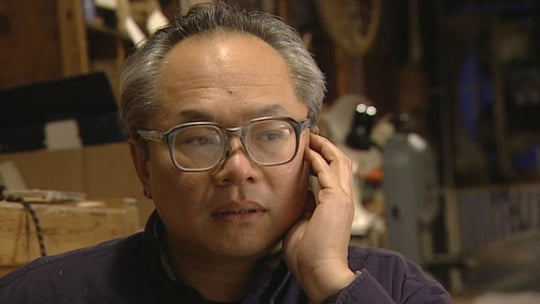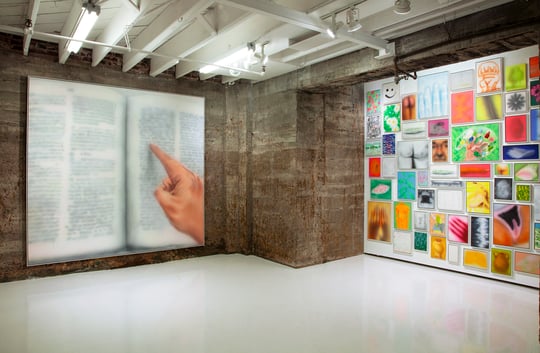
By Jerry Cullum
Kelly Kristin Jones’s exhibition “Cotton Is Still King (Although Robbed of Some of Its Dictatorship)” at Sandler Hudson Gallery is the artist’s response to the ubiquity in Metro Atlanta of historical signage that honors “mostly … a past war and dead white men.” She further remarks, in the explanatory brochure that accompanies her photographs and mixed media collages, that “the installation dates of these Civil War historical markers correlate with periods of tense race relations and represent a resistance to non-male, non-Christian, and/or non-white history.”
A quick perusal of one of the websites devoted to mapping such signage reveals that indeed, most were erected in 1955-56, with a few gaps filled in as late as 2011. They indeed mostly document the tortuous peregrinations of Union regiments striving to outflank and penetrate the defenses thrown up by their Confederate counterparts, although one of them erected in 1981 honors Mary Gay, whose account of her small role in the conflict remains a point of fond remembrance in certain circles.
Atlanta artists have been struggling for decades with the question of this historical overlay privileging a handful of days in 1864, and I myself contributed a 1993 poem that became the soundtrack of Carol LaFayette‘s 2003 video Skateboarding in Sarajevo in which the historical markers made cameo appearances. As part of a 2012 multimedia installation, Neil Fried, Evan Levy and Priscilla Smith produced a series of deliberately fragmentary rubbings that placed Atlanta’s Civil War signage “under erasure,” and William Boling created a 2005-06 series of photographs documenting the nondescript present-day surroundings of some of the most resonant pieces of signage commemorating the Battle of Atlanta. Other artists, including Gregor Turk and Lisa Tuttle, have dealt with the Civil War signage question more obliquely.

No one before Jones, to my knowledge, has attempted to fill in at least a portion of the history left uncommemorated at these sites, while digitally removing the existing signs themselves. (Boling simply left the historical markers out of the photographs, unless you count the Army Corps of Engineers’ spectacularly phallic cannon-barrel monument to Union General James McPherson.) Jones writes, “Each place holds more than a history of war and more than one version of Southern heritage. Stories in peace and war of women, children, non-Christians, and People of Color reveal the richness and complexity of our true Southern heritage.”
The stories she has gone about recovering and retelling range over a large number of topics: in “Cotton Is Still King,” landscape architect Frederick Law Olmsted’s forgotten antebellum narratives of travels in the South (the exhibition title is a quotation from one of these reports); in The Way She Put On Her Shoes, the women disguised as men who were prisoners of war in the Confederate camp at Andersonville (this is the only site in the exhibition that is distant from metro Atlanta); in Five Town Mice, an homage to the women whose activism led to the creation of Neighborhood Planning Units in the 1970s; in Stevenson’s Division (Now Am I a Negro?), the Negro Building at the 1895 Cotton States Exposition, in which Henry Ossawa Tanner’s iconic painting The Banjo Lesson was first exhibited; in Girls of the New South, the story of an anonymous contemporary lesbian residing or raised in the vicinity of the Civil War sign digitally removed from the landscape.
The series is ongoing, and it is easy to imagine the many other options that could further amplify Jones’s project. But its general format has been established here: a digitally altered photograph of the signage site minus the sign, and a box frame containing collaged materials that symbolize the alternate story being inserted, thus forming what Jones calls a “counter-memorial” contesting with the historical moment memorialized in the Civil War plaque.

Therein lie several ironies. Jones remarks in a recent interview that she is trying “to make the invisible visible. What’s problematic about these signs is not necessarily the history they’re presenting but when and where and why they were installed. The agenda behind the installation of these markers continues to this day, and they point to these recurring struggles for power and privilege, space and voice.”
She does, indeed, make visible some of the invisible participants in history, but their voices become available not in the artworks but in the brochure that accompanies the exhibition. The historical markers continue to tell their individual stories at the sites themselves; by removing them from the photographs, Jones reduces them, too, to off-site stories, texts accessible only by searching out online sources. In a way, the playing field has been leveled; the artwork in isolation gives us images but tells us nothing, although some of the titles tell us the name of the missing marker. The stories themselves remain a separate entity.
Attack from the West is perhaps the most opaque counter-memorial of all, since it incorporates images of the eyes of alumni of a recently extant school that does not appear in the photograph, and the title is taken from the historical plaque that has been so successfully removed that the photograph appears to be only a closeup detail of foliage. But apart from the newspaper clippings that line the frame of Five Town Mice, there are few unambiguous clues as to the nature of the alternative histories being honored in the counter-memorial frames.

Jones consciously chooses Photoshop’s misnamed spot-healing tool for her digital repairs where the markers have been deleted from the image. Sometimes the tool’s sampling of adjacent pixels results in a romantically seamless landscape; in other cases, it produces conspicuous scars that make it glaringly obvious that something has been taken out. This alternation between politely genteel erasure and unintended retention of the evidence of poorly healed wounds forms an appropriate analogy for the conflict of dominant and suppressed histories that Jones has taken as her subject, and in some cases provides a more arresting image than the anodyne pictures of nature that result when the tool has done its job more adequately.
Jerry Cullum is a freelance curator and critic living in Atlanta. His poems, reviews, and essays have appeared in a wide variety of local and national publications, including Art Papers and Art in America.

By E.C. Flamming
Kelly Kristin Jones, a Chicago native turned Atlantan, is, at heart, a storyteller and an archivist. Her new work at Sandler Hudson Gallery thoughtfully explores a complex Southern past through photographic reinterpretations of Confederate historical markers. While the removal of Confederate monuments has certainly made the news lately, Jones resists a simple documentary approach. She goes a step further by introducing new narratives from nearby residents, and in turn creates a strong and fresh exhibition.
But first—the title of the exhibition, “Cotton Is Still King (Although Robbed of Some of Its Dictatorship),” needs to be addressed. In the exhibition pamphlet, Jones explains the title is part of a quote from noted landscape architect Frederick Law Olmstead. The architect came to the South to discover “the peculiar virtues in the South,” where “Cotton is still king (although robbed of some of its dictatorship.” Quote or not, the title raises immediate red flags. By now, most everyone even slightly familiar with the controversy around Dana Schutz’s painting of Emmett Till, held up as example of white artists exploiting and profiting commercially from racial trauma that is not their own. Jones’s title reeks of the same insensitivity. Happily, the rest of the exhibition, though at times walking a thin line, generally avoids such thoughtlessness.
Jones uses Confederate historical markers as her focal point. These plaques that commemorate significant moments in the Battle of Atlanta, installed around the city at the edges of parks and along busy streets, tend to glorify white men who died fighting to preserve the slave economy, or more broadly, white supremacy. Jones digitally manipulates the black-and-white photographs to erase the monuments, though not completely. Here and there, you can clearly see the blurred outline of a sign post, or a shadow upon matted grass.

According to the exhibition pamphlet, after Jones “heals” the space, she expands on the history of the site by gathering stories from women, children, non-Christians, and people of color who live near, or even on, the sites. Jones then literally frames the large photographs with documentations of the new memories. For example, in Cotton Is Still King, the “new memorial” situated in the frame consists of Olmstead’s plans and notes for the Springvale Park design, as well as cyanotypes Jones made on the site from found objects, and even donated materials from park neighbors. Other frames are less archival and more personal, such as The South Got Something To Say, the frame of which contains pictures of Andre 3000.
Another eye-catching piece, Girls Of The New South, is framed with old Playboy photographs. The exhibition pamphlet contains an accompanying story by an anonymous women who describes finding her father’s stash of the titillating magazines as a young girl. The woman associates the site with her first encounter the magazines, and the following years in which she discovered her sexuality.
Every work has its own story, ranging from deeply personal to a broader portrayal of oppression, memory, and development. The photographs, with their semi-concealed erasures of Confederate monuments, are another story, one which has been warped and transformed by the “new” memorials. The works aren’t necessarily dependent on explanation to have significance. It’s entirely possible for the viewer to make up their own stories associated with the images in the frames. The photographs themselves are also quite arresting. Though haunted with a brutal and contested past, the exhibition holds its own with fresh ideas and excellent execution.
“Cotton Is Still King (Though Robbed of Some of Its Dictatorship)” is on view at Sandler Hudson Gallery through December 8.
E.C. Flamming is an Atlanta-based writer. She has been published in ART PAPERS, Paste, ArtsATL, and The Peel Literature & Arts Review.





